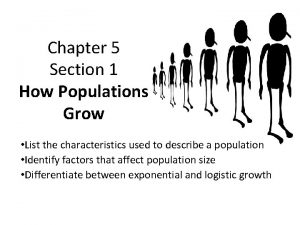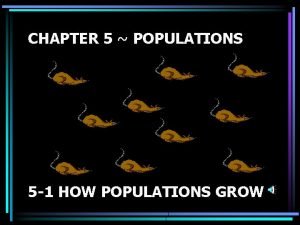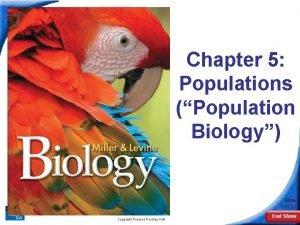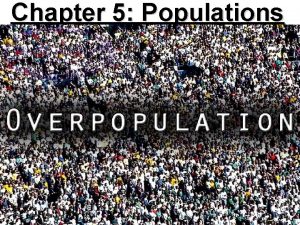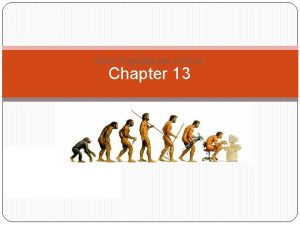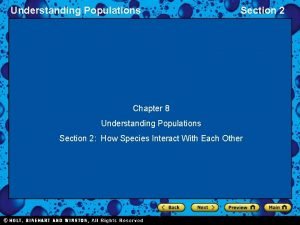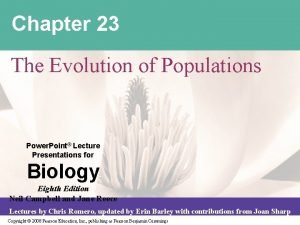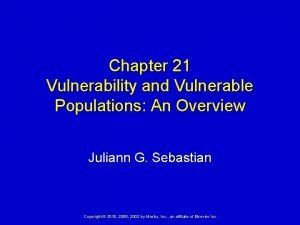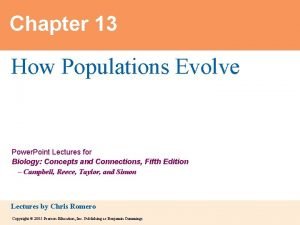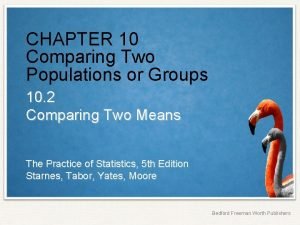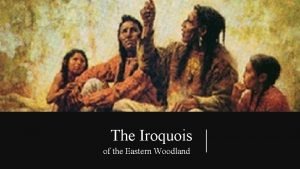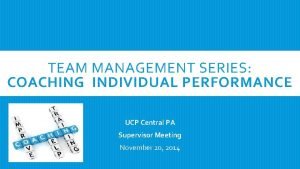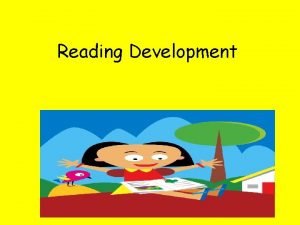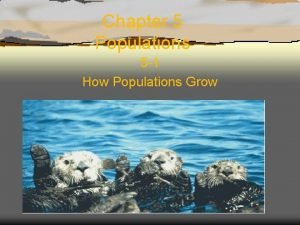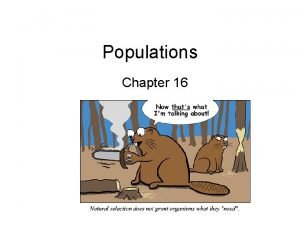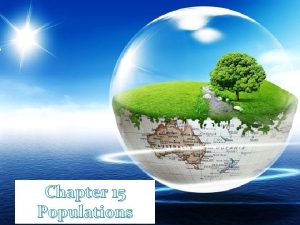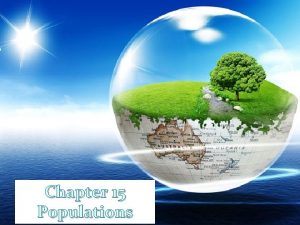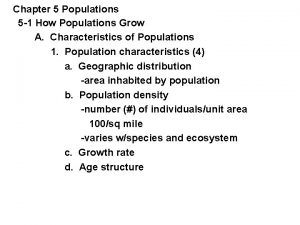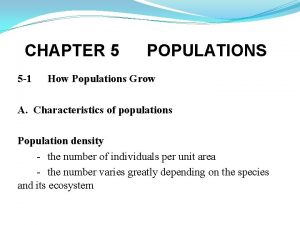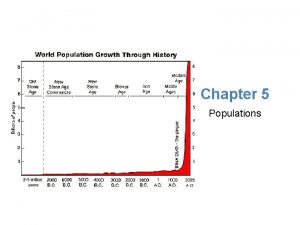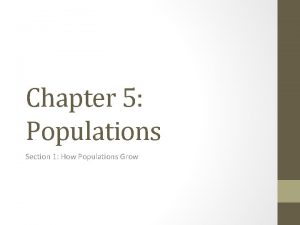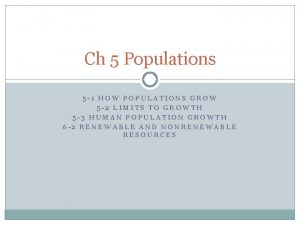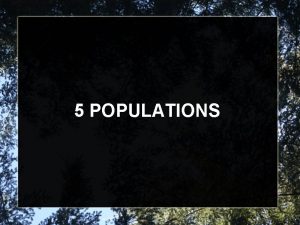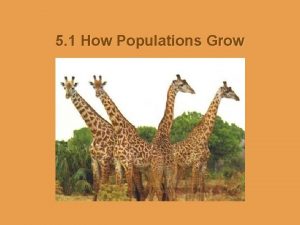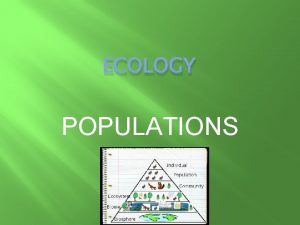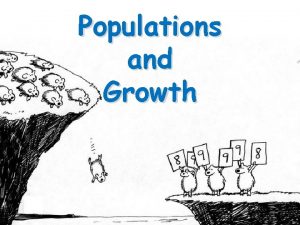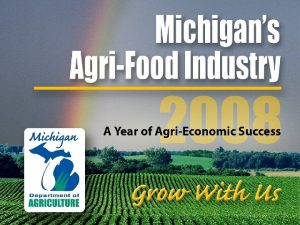Chapter 5 Populations 5 1 How Populations Grow

























- Slides: 25

Chapter 5: Populations

5. 1 How Populations Grow? Describing Populations How do ecologists study populations? n Populations are studied by ¡ ¡ Geographic range Density and distribution Growth rate Rate structure

Geographic Range n n Area inhabited by a population Can vary in size depending on the species

Density & Distribution n The number of individuals of a particular species at a specific place. The number of individuals per unit area. Distribution refers to how individuals in a population are spaced out across the range of the population. ¡ Random, Uniform, Clumped Refer to Fig 5 -2 For Example: the number of alligators per square mile of the everglades population = individuals = 400 alligators = 10 alligators density unit area 40 km 2 By measuring the population density of a specific species can give us a better idea of the effects of the environment in a specific area.

Patterns of Distribution

Growth Rate n Indicates whether the size of a population increases, decreases or is sustained.

Age Structure n The number of males and females of each age contained in a population.

Population Growth What factors affect population growth? q The factors that can affect population size. n n n q birthrate death rate immigration & emigration rates It depends on how many individuals are added or removed.

Exponential Growth q Is the growth of a population by a constant factor at constant time intervals. q Unlimited resources and absence of predation and disease, population will grow exponentially.

Logistic Growth n When a population’s growth slows and then stops following a period of exponential growth.

Phases of Growth n n n Phase 1: Exponential Growth Phase 2: Growth Slows Down Phase 3: Growth Stops

The Logistic Growth Curve n It occurs when a population’s growth slows and then stops, following a period of exponential growth.

Carrying Capacity ¡ ¡ ¡ Maximum number of organisms in a population that an environment can maintain. When birthrate and the death rate are the same. When immigration equals emigration.

Carrying Capacity n The population of seals before the early 1900’s kept this population below its carrying capacity. After the hunting was reduced, the seal population increased exponentially until it reached its carrying capacity. This Sshaped curve indicates a rapid increase in population for a period of time that will stabilize after reaching carrying capacity of the environment. Carrying Capacity Video

5. 2 Limits to Growth What factors determine carrying capacity? q Condition that restricts a population's growth, such as space, disease, and food availability.

Density-Dependent Limiting Factors ¡ Factor that limits a population more as population density increases. n Competition n Predation n Herbivory n Parasitism n Disease n Stress from overcrowding

Competition When populations become crowded, individuals compete for: n Food n Water n Space n Sunlight n Territories n Other essentials

Predation and Herbivory • Predator. Prey Relationships • Herbivore Effects • Humans as Predators Refer to pages 138 -139

Parasitism and Disease Parasites and disease causing organisms feed at the expense of their host, weakening them and often causing disease or death.

Stress From Overcrowding High level of stress can weaken the body’s ability to resist disease or it can cause females to neglect, kill, or even eat their own offspring. Limiting Factor video

Density-Independent Factors What limiting factors do not typically depend on population density? Unusual weather such as hurricanes, droughts, floods. Natural disasters such as wildfires. Fig. 5 -10 Limiting Factors Video

5. 3 Human Population Growth How has human population size changed over time? The human population, like populations of other organisms, tend to increase.

Historical Overview n n n The human population has increased explosively. Wide-scale farming began to replace hunting and gathering, providing a more plentiful food supply. More food meant people reproduced more and lived longer, and the population began to climb. In the past few centuries, death rates have continued to decline because of improvements in nutrition, sanitation, and health care.

Predicting Future Population Growth n n A city population's demands for food, water, energy and other supplies can strain resources far from the city. New technology, especially in agriculture and medicine, enabled more people to survive and reproduce.

Patterns of Human Population Growth Read Page 144 Refer to Fig 5 -12 Over Population video
 5-1 how populations grow
5-1 how populations grow Chapter 5 lesson 1 how populations grow
Chapter 5 lesson 1 how populations grow 5.1 how populations grow
5.1 how populations grow Population growth concept map
Population growth concept map Section 5-1 how populations grow
Section 5-1 how populations grow 5-1 how populations grow
5-1 how populations grow Think and grow rich chapter 10
Think and grow rich chapter 10 Chapter 16 evolution of populations vocabulary review
Chapter 16 evolution of populations vocabulary review Chapter 13 how populations evolve test
Chapter 13 how populations evolve test Chapter 17 evolution of populations answer key
Chapter 17 evolution of populations answer key Chapter 23: the evolution of populations
Chapter 23: the evolution of populations Chapter 16 evolution of populations
Chapter 16 evolution of populations Chapter 10 comparing two populations or groups answer key
Chapter 10 comparing two populations or groups answer key Chapter 8 understanding populations
Chapter 8 understanding populations Chapter 23 the evolution of populations
Chapter 23 the evolution of populations Chapter 21 vulnerability and vulnerable populations
Chapter 21 vulnerability and vulnerable populations Chapter 13 how populations evolve
Chapter 13 how populations evolve Chapter 10 comparing two populations or groups
Chapter 10 comparing two populations or groups Were free lets grow
Were free lets grow Subsistence sinew
Subsistence sinew Grow model example
Grow model example Living things grow
Living things grow In the poem watch me grow to what is reading compared
In the poem watch me grow to what is reading compared Help me grow sacramento
Help me grow sacramento Fe fi fo fum poem
Fe fi fo fum poem Philippians 3 14 nkjv
Philippians 3 14 nkjv
